Lenovo ThinkCentre M80q Tiny Gen 3 Internal Hardware Overview
Inside the Lenovo ThinkCentre M80q Tiny Gen3 is a familiar sight. We have a CPU area with a heat sink / fan and a drive and I/O area. Something we got with this unit, that we did not get with similar HP Elite Mini 600 and 800 G9 units is a 2.5” SATA drive holder. It seems like Lenovo is still including these even if the 2.5” drive is not ordered. That adds a bit more flexibility to this design.
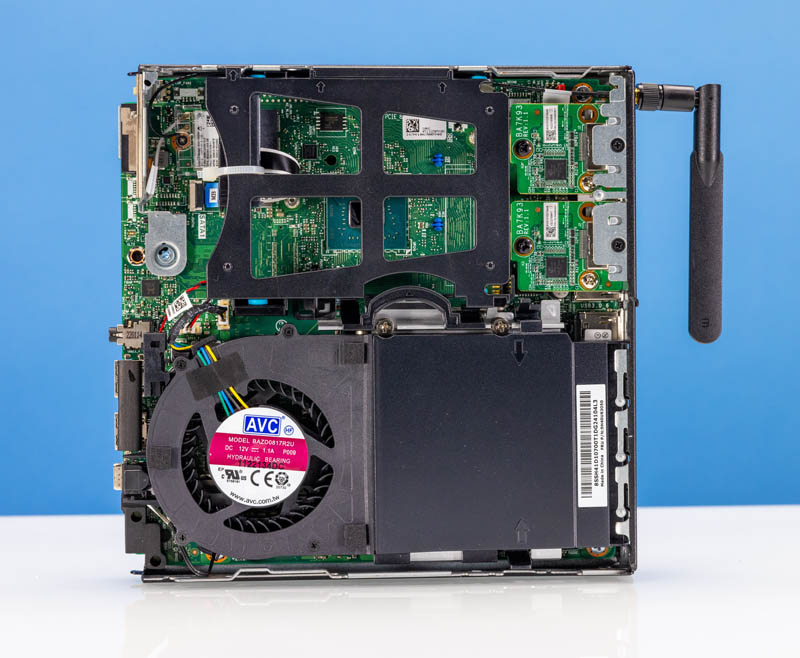
Pulling away the fan and shroud as well as the 2.5” SATA holder, we can see this area a bit better. The top area has an Intel AX211 WiFi 6E module installed, but there are many options. The big chip in the middle is the Intel Q670 PCH. There are also the two I/O expansion boards with DisplayPorts to the right.
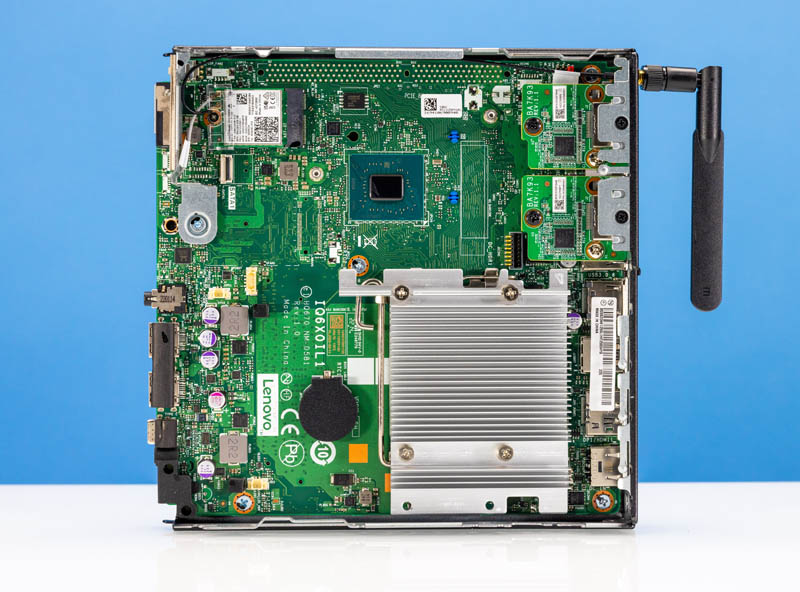
We can also see pads for the PCIe slot that is not populated in this system. We would see that populated in higher-end designs. Not populating this is a cost saving measure.
The heat sink is a relatively mundane design since it is for only 35W CPUs.
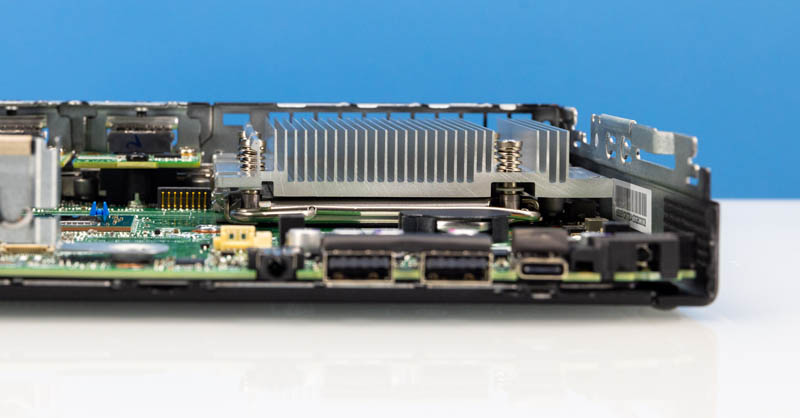
Lenovo’s big design feature that it has been doing for generations is that it moves the memory and the M.2 storage to the opposite side of the chassis. There is a bottom panel that slides off when the top cover is removed.
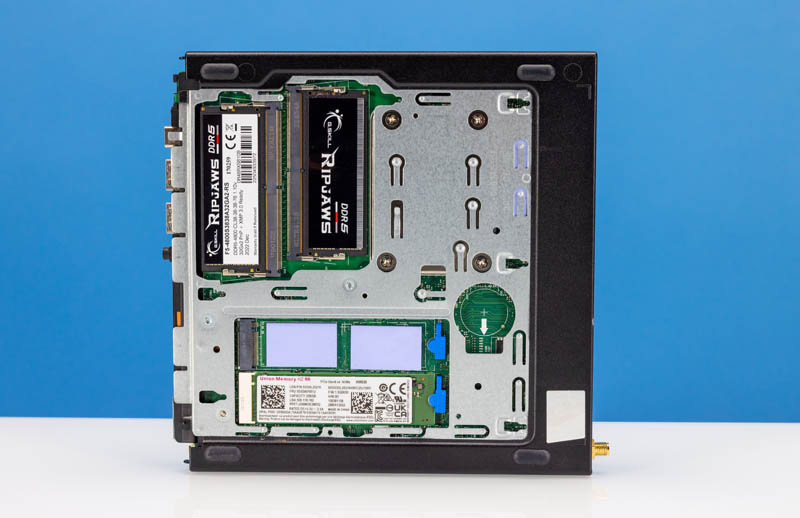
On the M.2 side we got a PCIe Gen4 x4 NVMe SSD from Union Memory. This is a joint venture designer from Lenovo. We have a CrystalDiskMark screenshot in the performance section. It is not fast. This also came with only a 256GB drive. We do like that Lenovo has two M.2 slots and that they are tool-less designs.
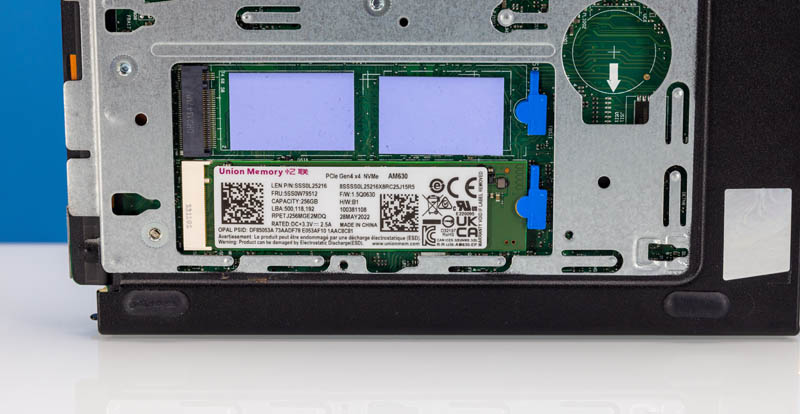
Our system came with 16GB of memory in one of the two DDR5-4800 SODIMM slots.
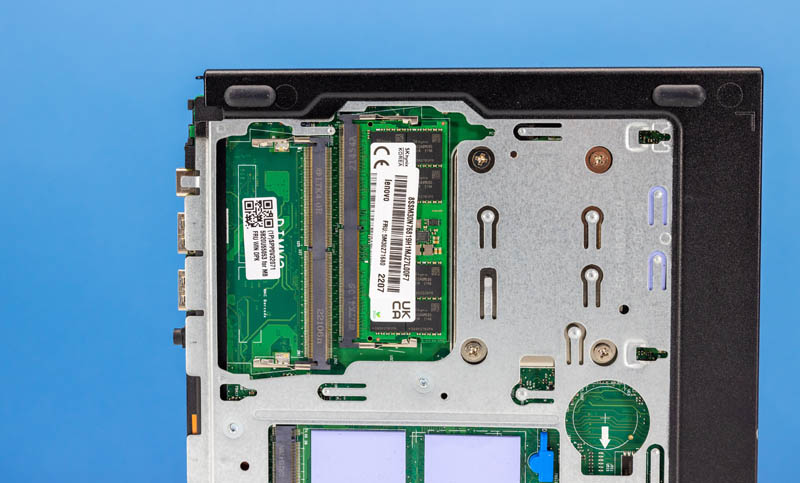
We tried up to 2x 32GB DDR5 SODIMMs for 64GB total.
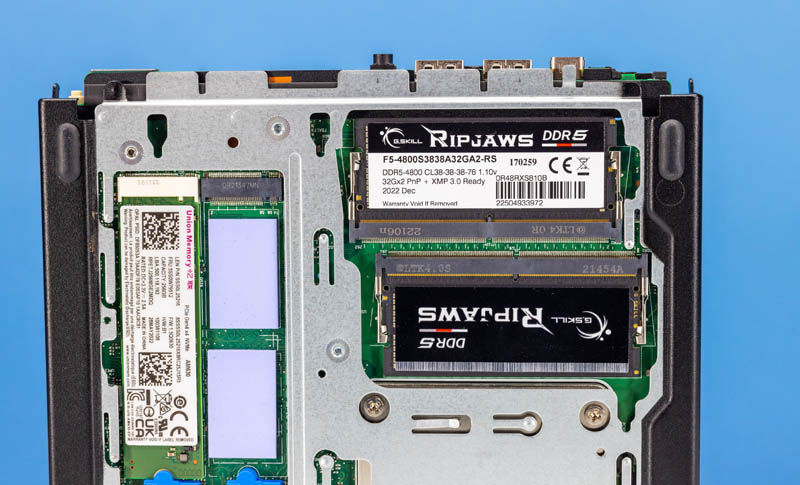
Overall, this is a nice package and we really like the Lenovo ThinkCentre 1L PC design. Lenovo probably has the best design with HP a close second.
Next, let us get to performance.
Lenovo ThinkCentre M80q Tiny Gen 3 Performance
As with all of these reviews, we wanted to look at performance quickly. We installed Ubuntu to validate Linux worked but also to provide some performance comparison with other offerings. We also had Windows 10 Pro installed for some of the storage testing.
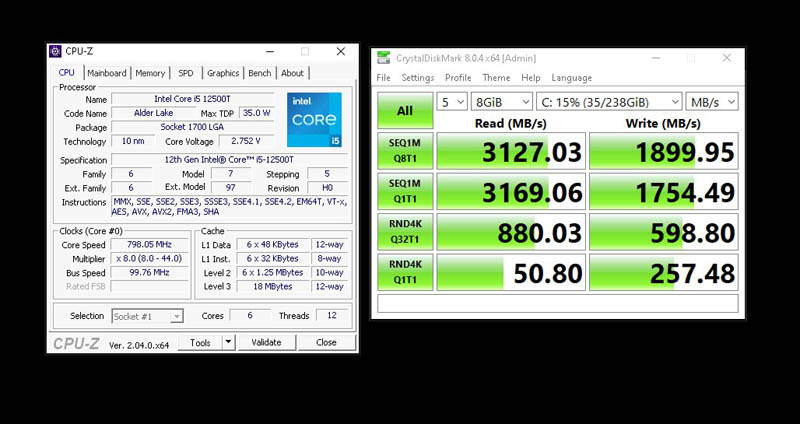
While the Intel Core i5-12500T we have seen before, something we wanted to mention was the PCIe Gen4 NVMe SSD. This 256GB NVMe SSD one may expect to see 6000-7000MB/s sequential reads/ writes. Instead, it is not that fast. 4K random speeds are OK and you will be unlikely to noticed the difference between this an either a faster Gen4 or a Gen3 drive for most applications.
Something else is that the Intel Core i5-12500T is the lowest-end model offered with Intel UHD 770 graphics. For those that want and upgrade from UHD 710 will want the Core i5-12500T or higher instead of the i5-12400T or lower.
Python Linux 4.4.2 Kernel Compile Benchmark
This is one of the most requested benchmarks for STH over the past few years. The task was simple, we have a standard configuration file, the Linux 4.4.2 kernel from kernel.org, and make the standard auto-generated configuration utilizing every thread in the system. We are expressing results in terms of compiles per hour to make the results easier to read:
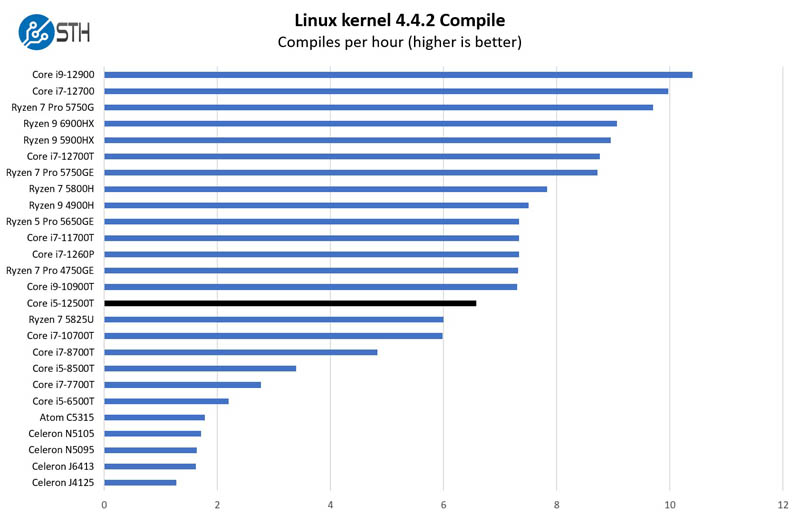
Here we see the Intel Core i5-12500T performance is good, but certainly far from what we would call “great”. At least we are seeing higher-speeds than previous generations.
7-zip Compression Performance
7-zip is a widely used compression/ decompression program that works cross-platform. We started using the program during our early days with Windows testing. It is now part of Linux-Bench.
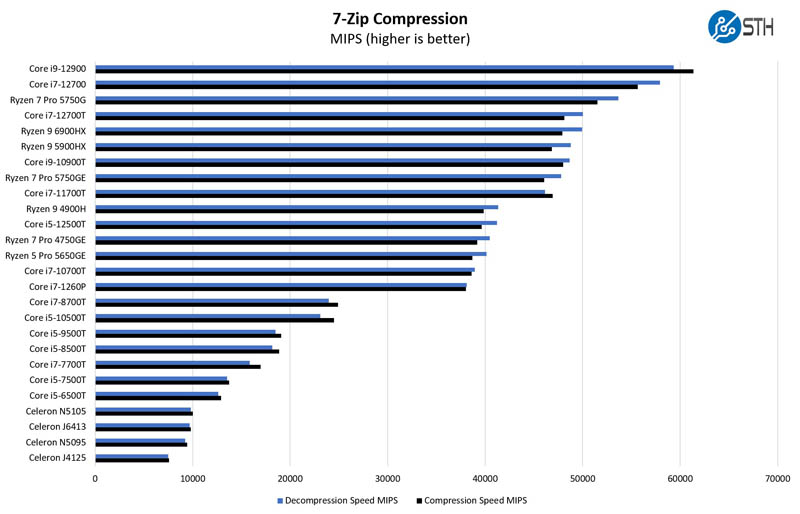
The Intel Core i5-12500T is a good performer, and it certainly outpaces previous generations. Alder Lake is a good platform.
OpenSSL Performance
OpenSSL is widely used to secure communications between servers. This is an important protocol in many server stacks. We first look at our sign tests:
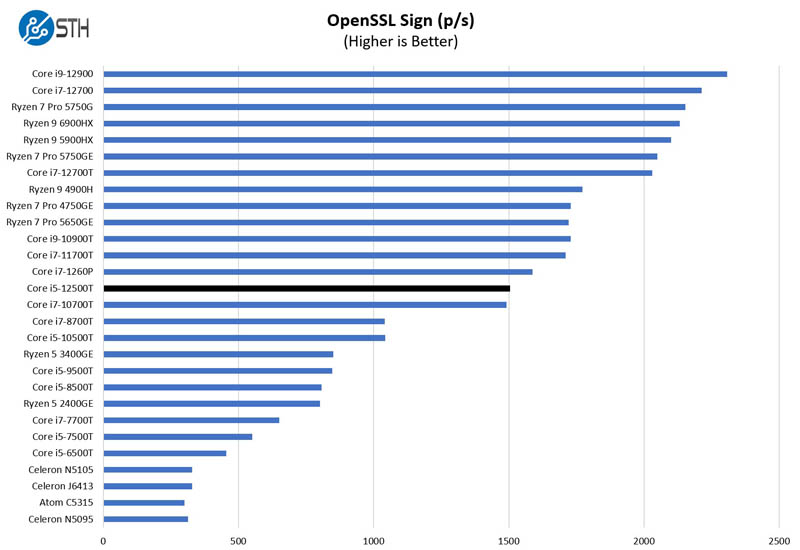
Here are the verify results:
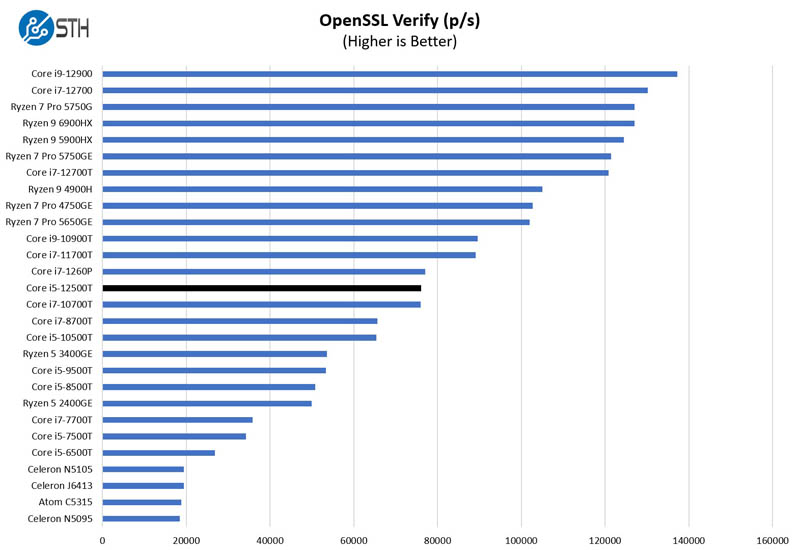
On the OpenSSL side, we see a similar story. These are starting to get close to the 8-core 35W TDP AMD Ryzen parts in 1L PCs.
Lenovo ThinkCentre M80q Tiny Gen 3 Geekbench 6 Results
We are not going into the details in-depth, but the HP Elite Mini 600 G9 we reviewed with the Core i7-12700T is a fairly large step up in performance with both P and E cores.
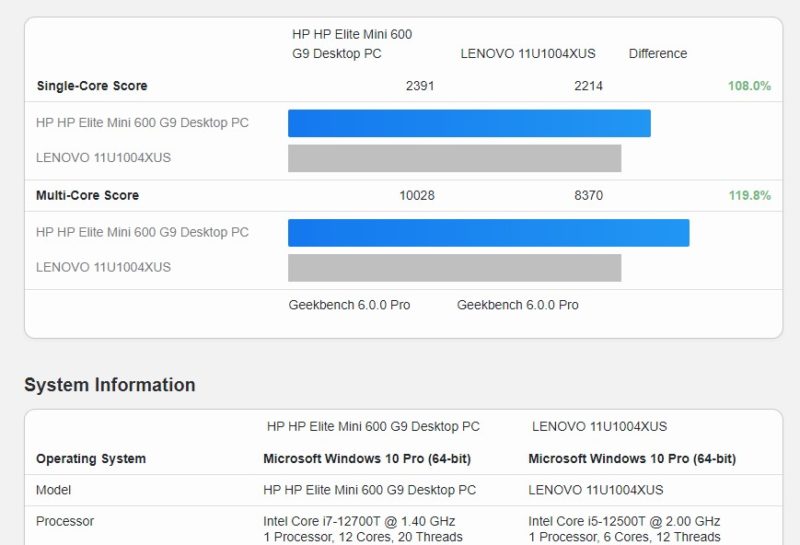
We were not expecting a 20% delta in this, but in other benchmarks the difference is higher. Often these 35W parts are so power/ thermally limited that the gains are often much smaller.
Next, let us get to power consumption and noise.




Hey Patrick, do these support ECC RAM? I saw on Intel’s ARK that the i5 12500T has ECC support but I wasn’t sure if the motherboards in these supported it. It would be awesome if they did…
An SSD with less than 24 hours use and a worn case go together about as well as a worn brake pedal and an odometer that shows low mileage. Are you sure that was the original SSD the system came with?
Used systems offered for bid as salvage may have had their drives removed as a security policy. Recycling such a unit for resale would then require installing a new drive.
The only place Union memory modules are sold is in Lenovo desktops IIRC. So I’d be like STH and assume that’s right for PoH of the entire system.
Normally these systems are on 24×7 so I’d say that’s low. But nobody’s installing a new 256GB union SSD.
P360 Tiny please
> If you had an OS, like VMware ESXi, that does not natively support heterogeneous cores then it is a good CPU.
I’m not sure what is meant by that. Could you clarify? And yeah, I’m not that a fan of P+E cores, I don’t see that much improvement in thermals or battery life compared to what AMD is doing with regular cores.
@Renard ESXi does not support running on mixed cores, it will panic unless you specifically boot it with an experimental parameter or disable one or the other class of cores.
Why no thunderbolt 4 ? Only on nuc ,no lenovo, HP, Dell